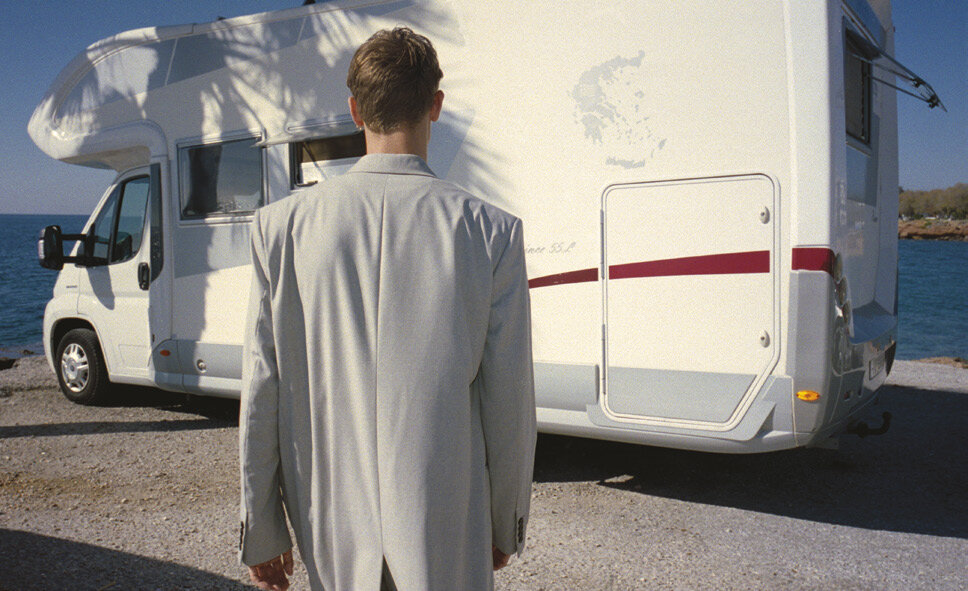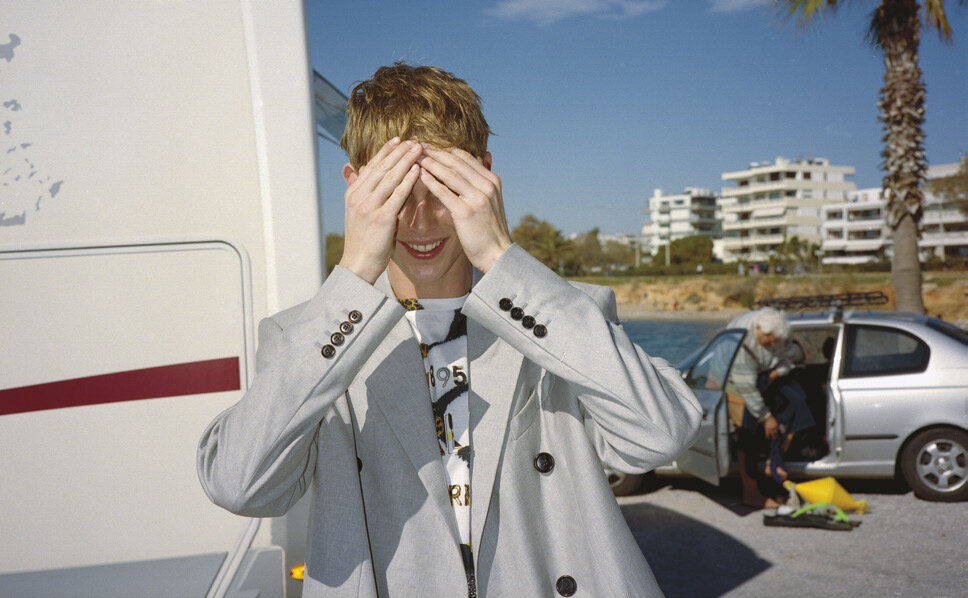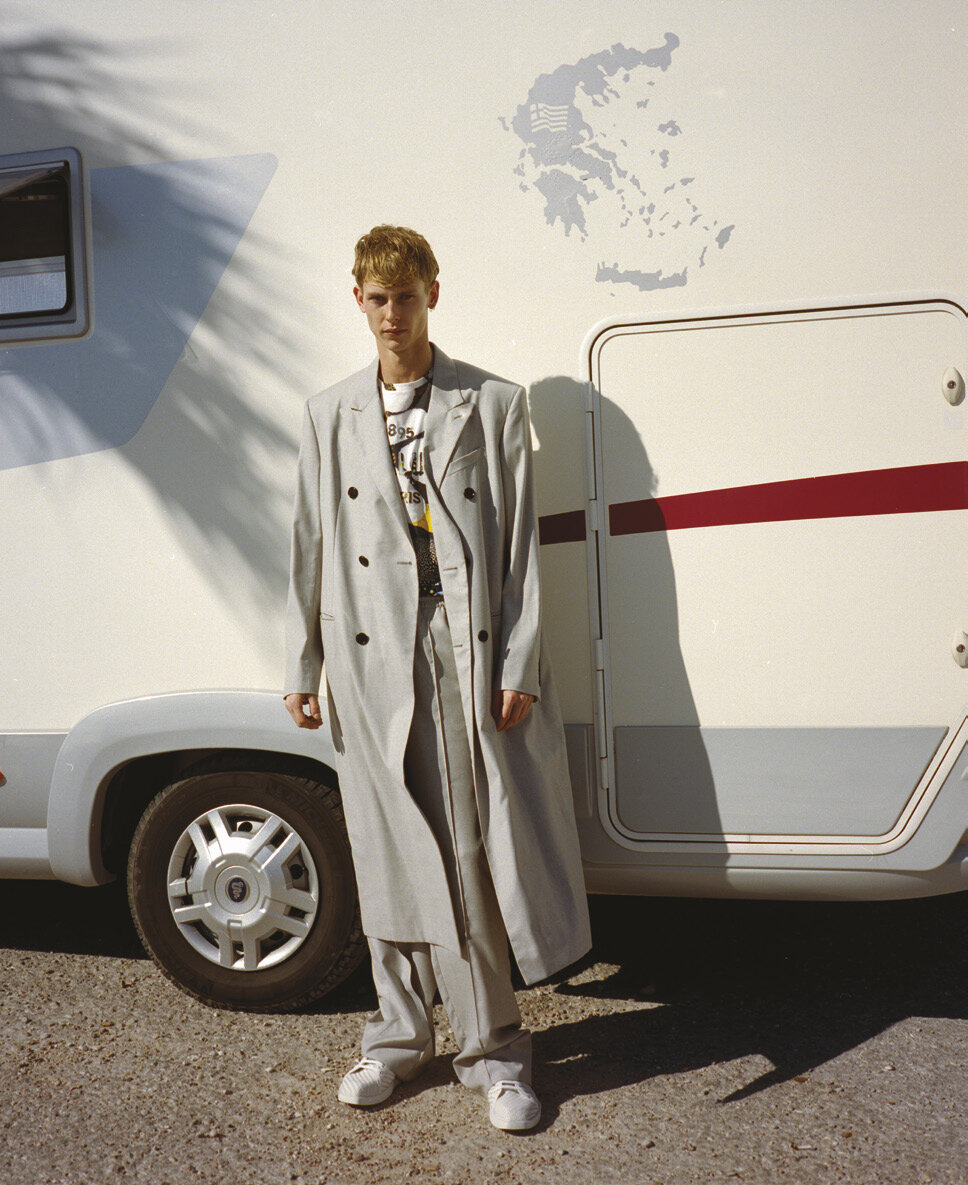💭 Kris Van Assche and Brian Rochefort for ODDA Magazine
This article first appeared in the ODDA Magazine 20th Issue “There is a Time”.
KRIS VAN ASSCHE AND BRIAN ROCHEFORT
For the first time during his tenure as the creative director of Berluti designer Kris Van Assche collaborated with a living artist to bring his SS21 menswear collection to life. And it was the colorful, textural, and freeform art pieces by the highly respected American ceramic artist Brian Rochefort that caught Van Assche's eye. An avid ceramics collector, Van Assche was able to reinterpret Rochefort’s bold and layered vision into silk prints shirts, three-dimensional knitted sweaters, and rich patinated leather Berluti accessories. The result is an elevated collection where artists, artistry, and the artisanal are celebrated in perfect harmony.
JESSICA MICHAULT. Talk to me about how you first discovered each other’s work.
KRIS VAN ASSCHE. I was interested in ceramics for many years. I started out with French ceramics from the 50s which was very in-line with the type of design that I love. I was into that for a long time. 50s ceramics are very beautiful but there is something restrained about it. What I really loved when I came across Brian’s work was the liberty and freedom that jumps at the eye. I had seen quite a bit of it over the years and then there was this major exhibition in London at the end of 2019. That was the first time that I saw such a big group of work together which made me really want to do something. That was the turning point for me. First, it was just about having the piece of it at my house but then I realized that it could become something else.
BRIAN ROCHEFORT. I knew about the brands that Kris was associated with, but I did not know Kris by name. I knew at the time that he was following me on social media but I came to know him through research that he was highly regarded because of his past work. I have a lot of friends in the fashion industry. All I had to do was call them up and they told me it would be a great opportunity for me. That is how I got familiar with Kris.
JM. In relation to ceramics, what is it about the medium that calls to you?
BR. I think it is good to understand my background. I am 35 and I have been doing ceramics full-time since I was 14 years old. Every semester throughout high school and college I got a degree in ceramics. Subsequently, I gained a fellowship, became a teacher, and now a full-time artist. So I have been doing this for so long and I am very passionate about it. Ceramics are very popular right now, but it is still unexplored. That is my goal with the material, to push it as far as possible. I come at the medium with a very expressive technique and approach. Color and texture are my things. Although it is very meticulous, I try to make it as expressive and wild as possible. I feel like I am pushing the boundaries a bit with the material, that is why my work is getting a lot of attention. I want to dissect the material, formulate my own glazes, and manipulate the chemicals to do something that is totally wild or not used in the traditional way.
KVA. I grew up in a very traditional family, I do not come from an artistic background. I knew at 12 or 13, that I really wanted to get into fashion, which was a weird thing within my family. Then I ended up going to the academy, then I learned about fashion, then fashion photography, then photography in general. Design came somewhere in the process. It is like a snowball that keeps on rolling. Through design came ceramics. The more our world becomes more digital, the more I like the human aspect of ceramics. In a very different way, that is why I used to like working with tailors. Every sleeve is done by hand and there are no two tailors in the world that will make the same type of sleeve. I am very sensitive to the human side of things. Brian’s work is very much about that, it really makes sense as an evolution.
“I am more solitary and this is the first time that I have worked in a collaboration of this scale. But I became very comfortable with it because it keeps things interesting for me, it was very refreshing to have another artist at the table.”
JM. You talk about artisan creation, yet your first collaboration at Berluti happened during the pandemic. Talk to me about that experience, dynamic, and if that hindered anything.
KVA. When I reached out to Brian, I had already one piece of his work in my collection so I could touch it. The truth about it is that we had no idea that we were heading towards a pandemic when we started this project. When I reached out to Brian, I thought that we were going to have a fashion show, I thought that it was going to be business as usual. I had been working for fashion for over 20 years and this never happened. It was not necessarily a big problem because what I like about Brian is the color explosion which was going to be the main focus. There is the artisanal approach which is Berluti and there is the artistic approach which is Brian. In that sense, it made sense to do it as the first collaboration. The first two years at Berluti for me was figuring out what my relationship between me and the brand was going to be. After two years, I felt quite comfortable that there was room for a third person at the table. There is something that I love about craft, but it tends to be difficult to push out of your comfort zone. That is where it is really nice to have an artistic influence, like Brian, and confronting them on their reactions to certain things. A good thing about Brian is that he works with a very good photographer and he has a very good way of documenting his work. That was a really good tool for us to work with. We gave the images to everyone working on it and it was an interesting work process that got the ball rolling, which is interesting because it is pushing people’s buttons.
“I am a pretty quiet guy but I create these very wild and colorful sculptures. I have always been that way. From what I have heard from other people is that maybe it is my alter-ego. Maybe it is a different part of me that is trying to escape.”
JM. Brian, did this collection push your buttons? Did you feel like you were surrendering your work for other people to have input on or did you feel like you were in control in terms of the back and forth in the work process?
BR. There was not too much back and forth. I pretty much surrendered all of my pictures to Kris and his team. I did not really push any particular image or piece onto Kris. I trusted him with whatever he needed. I submitted 80 images or so to choose from and he sent me some preliminary designs later on and I did not have any issue with them. I did not feel like I was in any position to do that either. I did my part by making these objects and Kris is the master of his craft and his own boss. There was no conflict whatsoever. I felt very comfortable doing it, that is why I signed up. If there was any hesitation, then it would be a different collaboration.
JM. Do you have the Berluti and Brian Rochefort collection now to enjoy?
BR. I do have one piece that Kris sent me which is the tote bag. It is the first piece that I have seen in real life and the details are amazing. I saw the layering and palpability in the images that Kris sent but when you see it in real life there is so much variation in sheen and texture. But I do know which ones I am going to get [when the collection arrives in the stores]. I am going to buy a bunch of stuff just to have forever. It is a really important project to me so I want to get as much as possible.
JM. Talk to me more about the challenges and surprises that went on and this collection.
KVA. It was definitely a challenging working process. Part of what we do as creative people is trying stuff, especially when you have a starting point such as Brian’s work. You want to go to all types of people and try to develop as much as possible. A big part of work is teamwork, I try to provoke things from creative people and see what we can get from what I throw at them. But all at once, all of that was put on hold. I realized that we would not be able to produce a collection as big as usual. I had to constantly select and edit my own work without being able to try it first, that was the case for the whole thing. It was very frustrating, but also quite interesting. It reminded me a little of when I used to have my own label where I had to edit really early in the process. It brings me back to certain moments of being a student. It is not the ideal way of working. But in the end, that did allow for the collection to come out great and I was happy about it but it is a frustrating way of working.
JM. Brian, your working process seems like a one-man show type of process. Are you on your own and what was this collaboration like in relation to your usual way of working?
BR. I work by myself in my studio. Even pre-pandemic, I had an assistant but I hardly required them. I really enjoyed being by myself in my own studio. I think that I will be working by myself as long as possible. The restrictions right now are size limitations. My sculptures are big and heavy so I have to lift them by myself so sometimes I have to get some help. One of the most difficult things is getting feedback during the pandemic. It is hard to get honest feedback from artist friends because they never want to give their honest opinion because they are afraid they are going to lose a friend. That is definitely a difficult thing as an independent artist, not having assistants around to pick their brains which a lot of big artists do. I am a pretty quiet guy but I create these very wild and colorful sculptures. I have always been that way. From what I have heard from other people is that maybe it is my alter-ego. Maybe it is a different part of me that is trying to escape.
JM. What were your biggest takeaways from this collection?
BR. There was a lot. For personal reasons, it was really exciting to expand my work and to see it in a different context. When I went to my school of design, they had a huge fashion & apparel department. I never even thought that I would dabble in it until Kris invited me to do this project. To see my work in this field is totally crazy. It is very exciting and it happened so quickly. When I first went into this agreement, I did not know how big of a project it would be and the extent Kris would bring it to with the storefronts and the designs he would produce. That was really exciting for me to see as an upcoming artist.
JM. Kris, how does it feel for you to be in the position to use the might and history of Berluti to give it as a platform to Brian to share his work with the world?
KVA. I do not see it like that, because Brian definitely does not need that. Brian has his own world and he does not need this publicity. For me, the pleasure about all of this is the conversations that happened. I am very comfortable with all this. I am similar in how I work, I am more solitary and this is the first time that I have worked in a collaboration of this scale. But I became very comfortable with it because it keeps things interesting for me, it was very refreshing to have another artist at the table. Although it might be a stretch to connect Berluti and Brian’s work, it was really well-received and that exceeded my expectations.
JM. With the rhythm of fashion shows, what was it like to not have that deadline on your back and be able to express yourself in such a different way?
KVA. I like fashion shows and I definitely feel that the risk of the current situation, judging everyone through a screen allows people to get away with a lot of crap. This situation is a risk for luxury because you cannot touch or see it in movement, there is too much that cannot be appreciated. It really narrows down the differences between high-end and mainstream. It is a high risk for brands like Berluti because you need to understand that difference. I am very frustrated about that and I hope that this will not last too long. I have surprised myself by enjoying making the video. I do not usually like to show people how work is done, I usually like to show the end result. But in June, it seemed like the best thing to do. I was surprised that I enjoyed explaining the work and that was something positive about this because we are able to have these types of deeper conversations.
In conversation with BRIAN ROCHEFORT
Conversation curated by JESSICA MICHAULT
Edited by DOMINIC CELEMEN
Photographer CHRIS KONTOS
Fashion editor GEORGIA TAL
Casting director DAVID MARTIN
Model OLIVER HOULBY @NewMadison
Grooming by CHRISTOS BAIRABAS @BeehiveArtists using AVEDA and BUMBLE AND BUMBLE
Fashion assistant ÉLIE MERVEILLE












